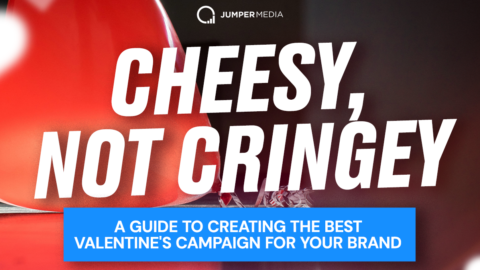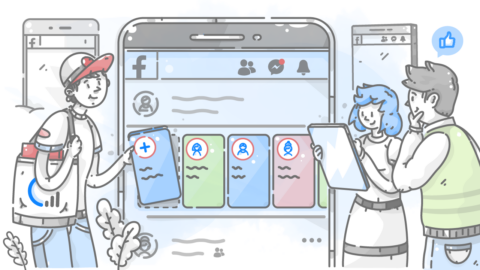Facebook advertising has long caused a divide in the marketing world. Some brands claim it’s the best thing since sliced bread, while others are convinced that online consumers are savvier than ever and blind to these ads.
So which one is it?
Are Facebook Ads a Must-Do or Are They Just a Waste of Time?
First things first, take a look at this chart from Facebook itself. Their revenue from ads has steadily increased over time, hinting that more and more companies are tapping into it as a marketing model.
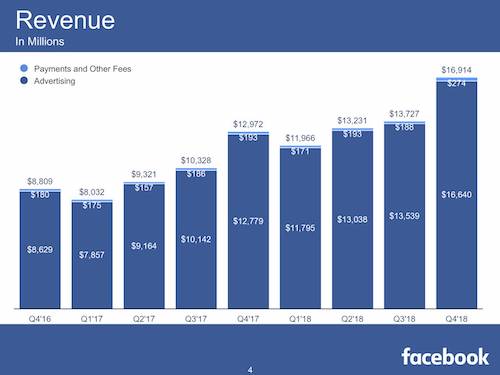
Source
Think about it:
Why would brands do this if they weren’t getting results?
Now, more than ever, we have access to advanced analytics that show us exactly what’s working and what’s not, which makes it easier to scrap techniques that aren’t bringing in the dough.
So if brands are spending their marketing dollars on them… do Facebook ads really work?
The short answer is yes — Facebook ads can be incredibly powerful for driving conversions and sales, but you’ve gotta know how to leverage them effectively.
Sure, Facebook provides unprecedented access to a massive audience, but if you’re not targeting the right people with the right message, your results aren’t going to be worth celebrating.
Why You Should Use Facebook Ads
There’s nothing like good old statistics to really shine the spotlight on the benefits of Facebook ads.

Source
Everyone is on Facebook
The most important thing to note is that your audience is on Facebook. It’s one of the largest social platforms in the world, with 1.49 billion users around the globe and more than 22 billion ad clicks every year.
If you’re under the impression your audience isn’t on Facebook… we’ve got some news for you. Unless you’re selling exclusively to mountain sherpas or the Amish, they are.
Ad Clickers Buy
Aside from the sheer number of people that use Facebook, the data on click-throughs and impressions will have you reconsidering if you thought consumers are blind to online ads.
In fact, 26% of Facebook users who have clicked on an ad are reported to have made a purchase from that initial click. This shows that there’s incredible selling potential if you target the right people for your product

Your Competitors are Doing It
No one likes to hear that their competitors are doing better than them. But what if we told you there’s a very high chance your biggest competitors are already out there rocking Facebook ads?
Don’t believe us?
Studies show that a massive 93% of social media advertisers use Facebook ads. These advertisers definitely wouldn’t continue to flock to the channel if they weren’t getting the results they wanted.
It’s Cheap
Finally, we know that price is an important factor in any marketing technique. Not all businesses have an endless supply of money and many have to keep an eye on their increasingly tight purse strings.
Luckily Facebook ads are a lot cheaper than other marketing methods. Just take a look at the graph below to see how they compare to other forms of advertising.
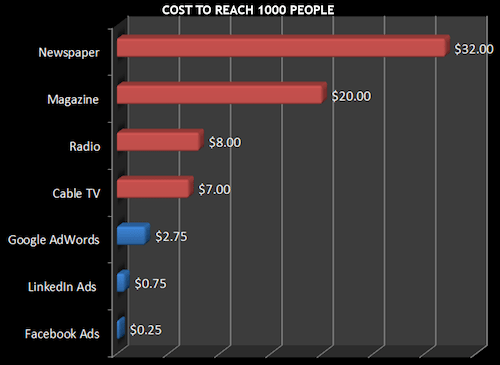
Source
How Facebook Ads Work
Facebook offers advertisers a variety of different ad formats, each of which can promote something different.
For example, there are ad options that let you directly promote your Facebook page, some that let you promote specific posts, and some that encourage users to click straight through to your website.

The ads appear in users’ news feeds depending on how they match a characteristic that the advertiser has specified. So, if you’re a male between the ages of 30 and 45 living in Austin, Texas, and that’s who the advertiser has chosen to target, there’s a high chance the ad will appear in your feed.
Sometimes ads are simply images of a brand’s product, sometimes they are videos, and other times they feature a selection of different products in a catalog (or carousel) format.
The power of Facebook ads lies in the backend operations.
Through the “Manage Ads” section of Facebook, advertisers can create detailed campaigns that are really targeted to reach a certain kind of user.
The ads are created in three layers. At the top level, you see “Campaigns,” where you determine what you want to achieve with your ad.
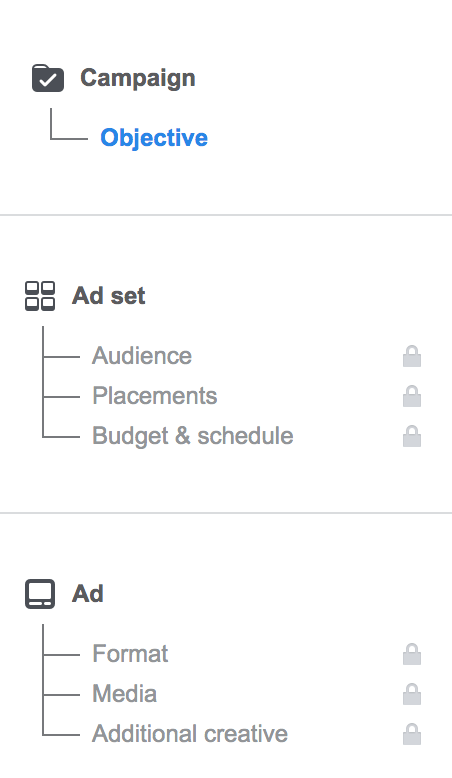
In the next layer, there are “Ad Sets,” where you choose who you want to target, where you want your ads to be seen, and how much you want to pay.
The final level is all about what your ads look like. This is where you choose what format your ads take, and what visuals and copy gets included.
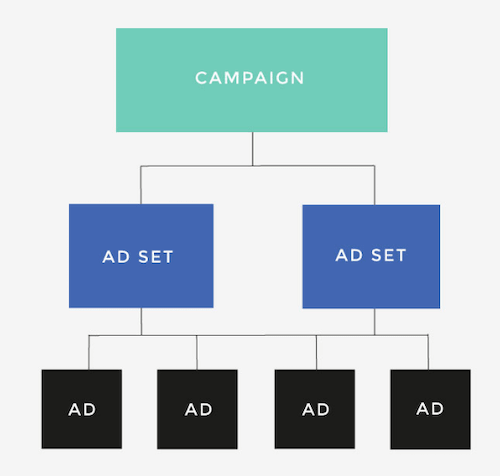
How to Set Up a Facebook Ad
Facebook’s ad manager makes it easy to create campaigns, ad sets, and individual ads.
Here’s how you get started:
Step 1: Set Goals for Your Facebook Ads
This should be considered offline, before you even think about creating an ad campaign.
Your goals should be aligned with your business needs and aims, whether it’s to get 1,000 new sales in a year or 200 new likes on your Facebook Page by next month.
Once you’ve determined what you want to achieve with your Facebook ads (because how will you know if they’re doing well if you don’t have an end goal?!), you can move on to the next step and actually venture into the ads manager section of Facebook.
Step 2: Facebook Ads Manager
This can be accessed from the dropdown arrow at the top of your Facebook feed. Once you’re in the manager section, you can click the “Create” button which will bring up a page for you to select an objective for your campaign.

Step 3: Choose Your Objective
Your objective will depend on the goals you decided on for your campaign. You might want to boost engagement, get more video views, or generate more leads.
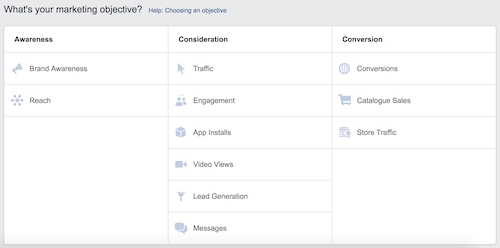
When you choose an objective, Facebook will automatically show it to people that, based on their previous behavior, are more likely to react to your ad in the way you want.
Jumper Media’s content creation services help your company or small business stay relevant in today’s social, digital world.
Find out about our Social Media Content Creation Services.
Step 4: Define Your Audience and Budget
Next, it’s time to decide who matches the target audience for your ad.
The great thing about Facebook ads is the targeting is super specific. As well as reaching users who are a certain age or live in a certain area, you can target people based on their interests, whether they’re homeowners, their approximate household income, and other details that determine what kind of people they are and what problems they need solutions for.
You can also target specific people based on their:
- Gender
- Connections
- Relationship Status
- Languages
- Education
- Workplaces
There are also broader interest categories, such as hobbies and activities that users like doing, as well as time-based segmentation, like people who have been engaged for a year, people who are expecting a baby, or people whose birthday is in a week.
Finally, you can choose to target people by the pages they’ve liked, the apps they use, and other information they’ve provided on their profile, even reversing the filter with exclusions.
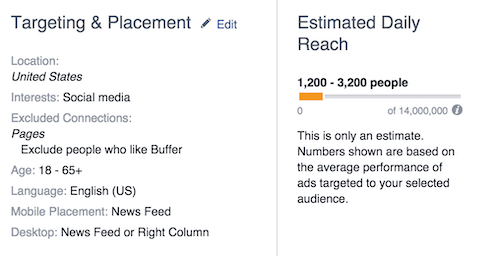
When you start to narrow down who you target, Facebook will provide an estimation of how many people your ad is likely to reach.
The more targeted you get, the better your results will be. So, instead of targeting people who simply like “yoga” in general, try researching what kind of magazines yogis read and target fans of those instead. The key is not just to reach interested people, but to reach interested people who are likely to buy from you.
After choosing who you want to target, you’ll be prompted to choose your daily or monthly budget.
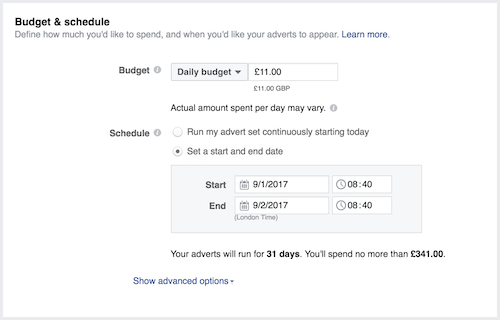
Step 5: Format Your Ad
Now it’s time for the fun part.
This is where you’ll choose the type of your ad, whether it’s a video, single image, slideshow, or a carousel of products, and design the actual ad from the ground up.

In this section, you’ll be prompted to enter your headline copy, body copy, and call-to-action as well. If you’re stuck for what to write, the AIDA copywriting formula is a good place to start:
- (A)ttention – use an attention-grabbing headline to capture user eyeballs
- (I)nterest – briefly describe what it is you’re offering and how it will benefit the user.
- (D)esire – create a sense of need by offering a free trial, a free download, a discount, or some kind of limited-time offer.
- (A)ction – make sure you end your ad with a powerful call-to-action.
When it comes to choosing your visuals, make sure you keep it on-brand so that people begin to recognize you and associate your colors and fonts with your business. It’s also a good idea to keep things bold and eye-catching so your ad stands out on a feed full of other content.
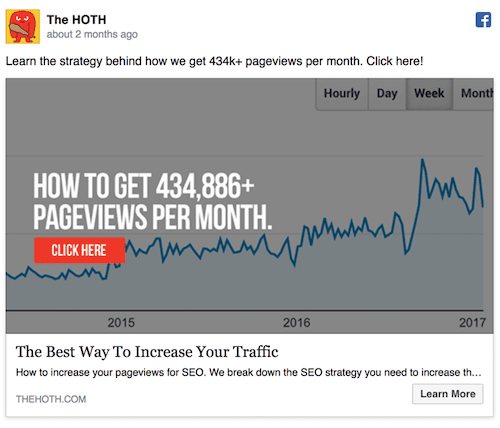
Step 6: Choose Your Ad Placements and Away You Go
The final step is choosing where you want your ads to show up. You have the option of in-feed (which is the most common), in the sidebar, on desktop, mobile, and on Instagram feeds.
Consider your original goals again for this step, although we recommend selection the in-feed option on both desktop and mobile to begin with as these get the most visibility.
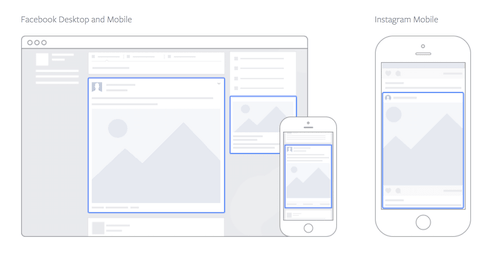
The Power of Facebook Ads
The naysayers about Facebook ads hasn’t stopped the platform from performing incredibly well for brands all over the world. To get the best results from your Facebook marketing, though, the key is to be specific.
That means being particular with who you’re targeting, what you’re offering, and in the messaging you’re putting out there. The more focused you can be, the more relevant users you’ll reach, and the more success you’ll have.


